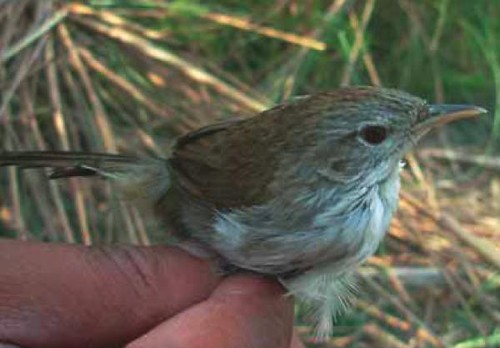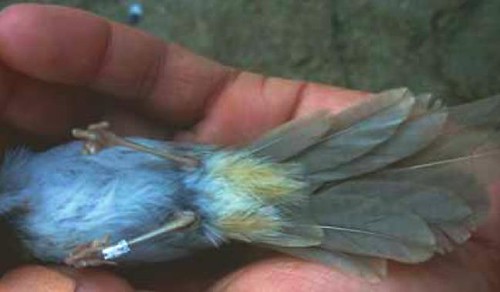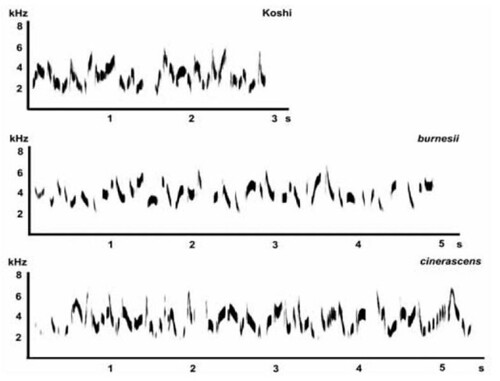tags: researchblogging.org, birds, Nepal Rufous-vented Prinia, Prinia burnesii nipalensis, ornithology, speciation, new species, Nepal
A new subspecies of the Rufous-vented Prinia, Prinia burnesii,
has been found in Nepal. This new bird is now known as the
Nepal Rufous-vented Prinia, Prinia burnesii nipalensis.
[larger view].
A new subspecies of bird has been discovered on marshy grasslands located on small islands in Nepal's Koshi River. This new subspecies is similar to two other previously described subspecies of the Rufous-vented Prinia that are found along rivers in Pakistan and India and thus, forms an important intermediate link between them. This new subspecies is now known as the Nepal Rufous-vented Prinia, Prinia burnesii nipalensis.
The other two sister subspecies of the Rufous-vented Prinia are Prinia burnesii burnesii, which are found to the northeast along the tributaries of the Indus River of Pakistan and the adjacent Punjab in India, and Prinia burnesii cinerascens, which are located to the southwest in India along the Bramhaputra river and in portions of nearby Bangladesh.
Subspecies is a taxonomic ranking that is subordinate to species because they are less distinctive than full species. Some species have many subspecies while others have none at all. Subspecies are generally geographically or reproductively isolated from each other, although birds -- because they use song to attract mates -- can be isolated from each other solely based on their song. But regardless of what sort of living thing they are, when subspecies remain isolated from each other long enough, they too, evolve into full species status, unless they become extinct.
The adults of the newly described P. b. nipalensis (figures 1 & 2) have olive-grey to light brown plumage, which contrasts with the warmer chestnut color of its western sister subspecies, P. b. cinerascens, and the ashier grey plumage of P. b. burnesii.
Figure 1: Dorsal view of the newly described
Nepal Rufous-vented Prinia, Prinia burnesii nipalensis.
Figure 2: Dorsal view (open wing), of the newly described
Nepal Rufous-vented Prinia, Prinia burnesii nipalensis.
Well, it is difficult to see in the above images, but the bird's head and nape are greyer than its back, wings and tail, all of which are browner in color. Further, there is a faint whitish supercilium ("eyebrow" stripe) in most individuals. The head and upper back have bold brown streaks. Also notice the short, round wing that indicates a relatively sedentary life style. As you can see below, adults also have a cream colored belly with pale rufous colored tail coverts (figure 3);
Ventral view of the newly described
Nepal Rufous-vented Prinia, Prinia burnesii nipalensis.
The juveniles have similar markings to adults but the markings on the head and body are fainter and less defined. Additionally, one young bird that was caught had light rufous under-tail coverts.
These subspecies have very distinctive songs, as revealed by recordings and sonagrams (figure 4);
Figure 4: Sonagrams of several other described subspecies of Rufous-vented Prinia. (note: "Koshi" refers to Prinia burnesii nipalensis).
According to Dr Hem Sagar Baral of Bird Conservation Nepal (BCN), this subspecies of bird is currently found only in Nepal. But unfortunately, as with most newly described bird species, this species is considered to be threatened because of its small population and its sensitivity to habitat disturbance. Currently, it is thought that there are no more than 500 individuals alive today. But luckily for the birds, they live on a reserve in Nepal, Koshi Tappu, that is well monitored by birdwatchers, so Dr Hem is hopeful that these birds will be protected and that more species of birds might be found there because it is the most popular site for bird watching in winter in Nepal.
This new subspecies increases Nepal's total bird list to a very impressive 862 species (compare to the United States -- a much larger land mass -- with something like 900 or so species).
The formal description of this bird subspecies was published in Danphe, the official publication of Bird Conservation Nepal.
Sources
Hem, S.B., Suchit, B., Badri, C., Hathan, C., Tika, G., Som, G.C. (2007). A New Subspecies of Rufous-vented Prinia, Prinia burnesii (Aves: Cisticolidae) From Nepal. Danphe, 16(4), 1-12 [free PDF]. (data, quotes, images).
Nepal News (quotes).
- Log in to post comments






I bumped into the related (?) YELLOW-BELLIED PRINIA in the Pleiku, Vietnam area when I was there as a US Army soldier (medic) in 1968/69.